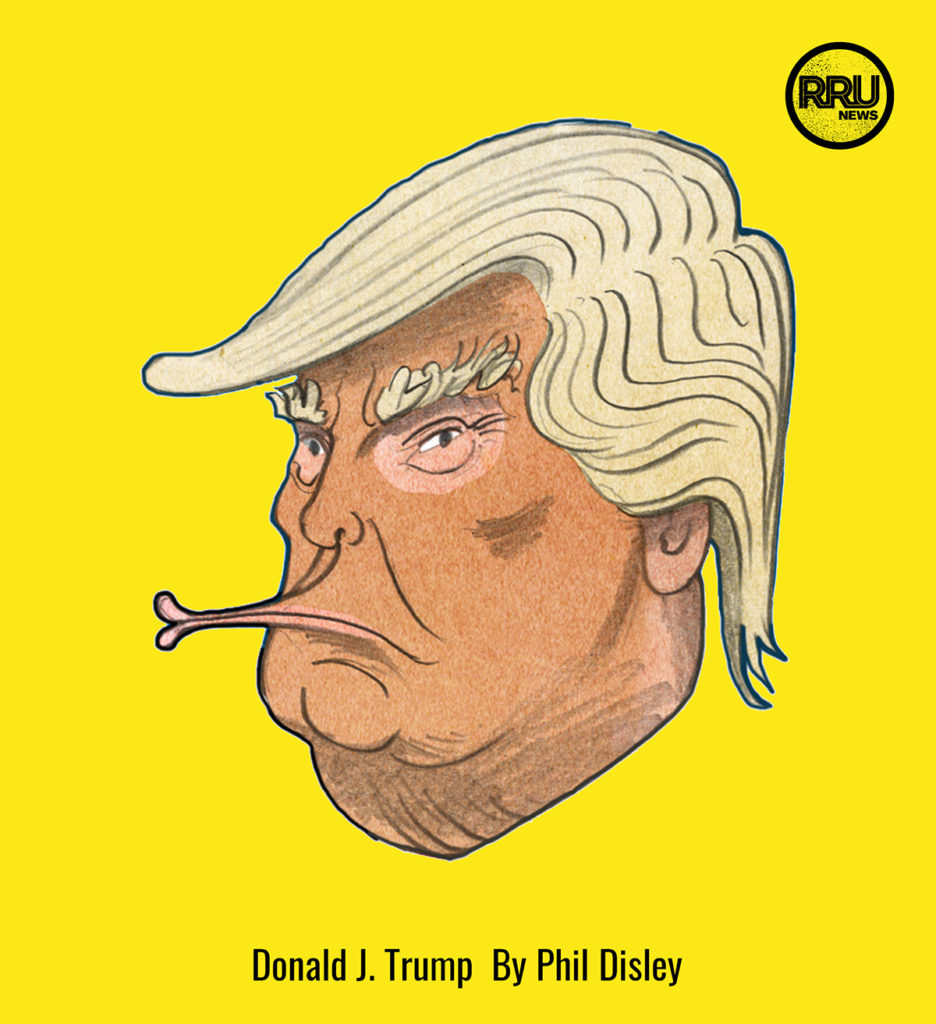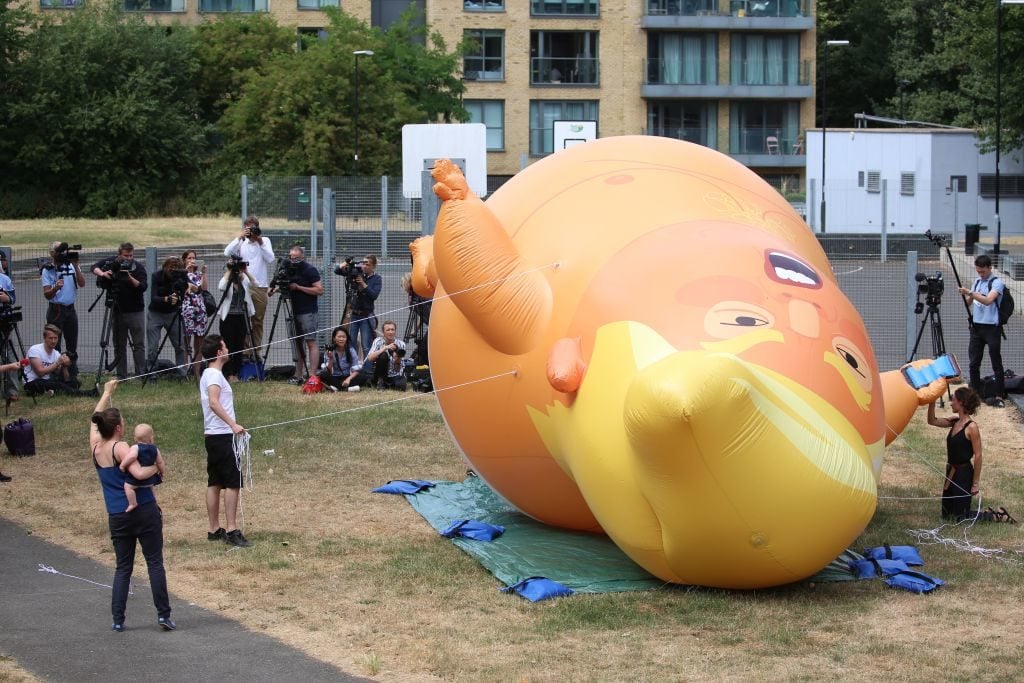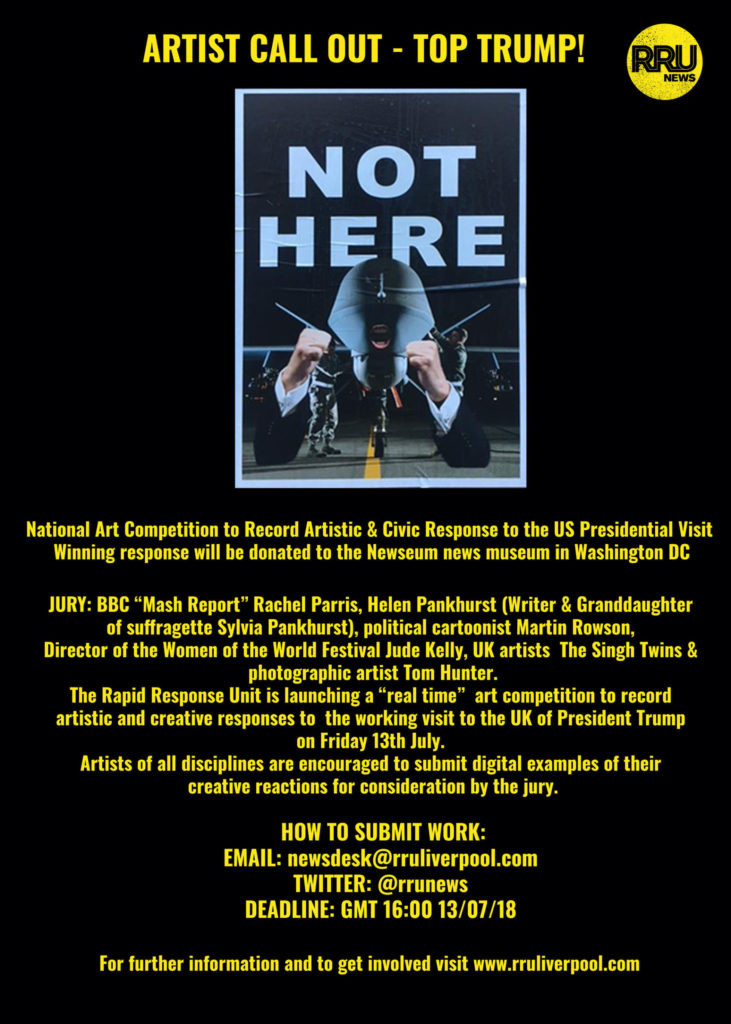Politics
An Upstart UK News Organization Is Running an Anti-Trump Art Contest. The Winning Work Goes to a DC Museum
As the US president arrives in the UK, the Rapid Response Unit is looking for creative contributions to the debate.

As the US president arrives in the UK, the Rapid Response Unit is looking for creative contributions to the debate.

Naomi Rea

As Donald Trump lands in the UK today, July 12, to begin his contentious four-day working visit, an upstart newsroom in Liverpool is seeking artistic responses to the historic moment. The winning work will follow the US president back to Washington, DC, where it will enter the collection of the Newseum.
The art competition was launched by an experimental cultural initiative working out of an independent news bureau called the Rapid Response Unit, which usually commissions artists of all disciplines to make work inspired by a story or topic in the headlines. “This project is ultimately an experiment asking ‘Can artists play a bigger role in the news cycle than they previously have?’” RRU News editor-in-chief Mark Donne explains to artnet News.
The RRU initiative came about in Liverpool after Brexit. The city was European Capital of Culture in 2008—an honor no other city in Britain will now be eligible for. Reflection on the significance of that new isolation, combined with a wider public conversation around propaganda and “fake news” online, sparked the idea of a new kind of art initiative.
“We looked at the sort of different identities in society that the public don’t usually trust, like politicians or bankers or estate agents,” Donne says, “and all of a sudden we saw journalists were being put into that same group. So at that point we thought it would be very interesting to take a body of people the public generally do trust, which is artists, and have artists coming in and interpreting and challenging and changing notions of how we receive news.”
RRU News’s latest project is a national art competition to record artistic and civic response to Trump’s UK visit. (Officially, it was downgraded from a proposed full state visit after concerns about nationwide anti-Trump protests.)
Anti-Trump art has been pouring out since before the election, from unflattering naked statues to, more recently, the political cartoons of comic actor turned modern-day Daumier Jim Carrey. Among the notable artistic responses to Trump’s UK visit that have already garnered attention are the Mexican artist Bosco Sodi’s brick wall, which has appeared on London’s South Bank, and the British activist Leo Murray’s giant inflatable “Trump Baby” balloon, which got permission from London’s mayor Sadiq Khan to fly over Westminster during Trump’s stay.

Activists inflate a giant balloon depicting US President Donald Trump as an orange baby in north London on July 10, 2018 ahead of a demonstration in London to coincide with the visit of the US president. Photo by Isabel Infantes/AFP/Getty Images.
But Donne says he wants the competition to be as pluralistic as possible. “Trump is such a caricature. He’s someone who—if you look at polling in Britain—is almost universally loathed, so when you’ve got someone who is so bombastic, so grotesque in terms of the caricature that he’s built, a lot of what is made creatively, mostly in protest, is actually quite prosaic,” Donne explains. “It’s not that interesting.”
Donne says he’d like to see an artist aptly capture the wider historical moment. He mentioned an artist friend’s idea about visually representing the two and a half million votes more that Hillary Clinton received during the election as one possible tack. Given that the winning response will be donated to the Newseum in Washington, DC, Donne also sees Trump’s combative relationship with the media as ripe subject matter.
“There are very few titles, apart from Fox News in America, that he hasn’t personally attacked and demonized,” Donne says, “So I’m sort of hoping that there will be something quite salient that comes in that actually works quite well for the Newseum.” The museum, located near both Congress and the White House, is dedicated to to increasing public understanding of the importance of a free press. Whatever comes out of it will be a permanent memento of the current news moment, Donne says, “because it’s going to be the biggest, busiest news day of the year.”

RRU News image for the contest. Image courtesy RRU News.
Along with the more conventional artistic submissions that have been pouring in, the newsroom is sending a photographer, Rachel Megawhat, to be on the ground as a spotter, as Donne notes that sometimes crudely made objects or spontaneous moments can turn out to be very effective and beautiful interventions.
Donne, however, is not on the prize jury, which consists of a group of experts covering several important spheres of interest. Rachel Parris, of the BBC’s satirical news digest the “Mash Report” brings both a news and comedy perspective to the judging, while the feminist activist and writer Helen Pankhurst, a descendant of the suffragette dynasty, brings her experience with public demonstrations to the mix.
Then there’s Jude Kelly, the director of the Women of the World Festival, and Liverpool-based artists the Singh Twins, as well as the art photographer Tom Hunter, who bring multiple perspectives to the submissions. Finally, there’s an acclaimed British political cartoonist, Martin Rowson, who brings a journalistic, artistic, and humorous lens to the panel.
Oh, and in all the excitement I forgot to crow "Been there, done that!" sufficiently loudly. These are both from December 2016, in @Chartist48 & @guardian. Welcome to Narnia, @realDonaldTrump, you risible fascist orange abortion pic.twitter.com/lLcRPurKXj
— Martin Rowson (@MartinRowson) July 12, 2018
Rowson told artnet News that when it comes to satire, nuance is all but irrelevant. We need satire “to even up the balance between the powerful and the powerless.” The purpose of political satire, he explained, is not to change behavior but to empower us to laugh, adding that “a mark of [Trump’s] fascist instincts is his demand that we take him seriously.”
Rowson was at the American Association of Editorial Cartoonists convention in Long Island last November. A live topic among his American colleagues was how to satirize Trump effectively, given that he is already so extreme. To find the answer, Rowson compared Trump to Britain’s former Foreign Secretary Boris Johnson, saying, “although their skin appears to be about 12 inches thick, it’s actually microns thin, and they are both fueled entirely by the need for the approbation of other people.”
Figures like Trump and Johnson, he argues, get the joke in first so that people are laughing with them rather than at them. “The president of the United States waking up every Sunday morning and tweeting about how he was portrayed on Saturday Night Live the night before is not the action of a man who is impervious to satire,” Rowson says.
What will he be looking for as a RRU News juror? “I think I think you’ve got to capture what he looks like, that’s the most important thing, and to do that weird kind of primitive voodoo where you, by caricature, capture some sort of deep inner truth. And then it actually has to be funny.”
The deadline for submissions to the TOP TRUMP National Art Competition is tomorrow, Friday 13 July, at 4 PM GMT.